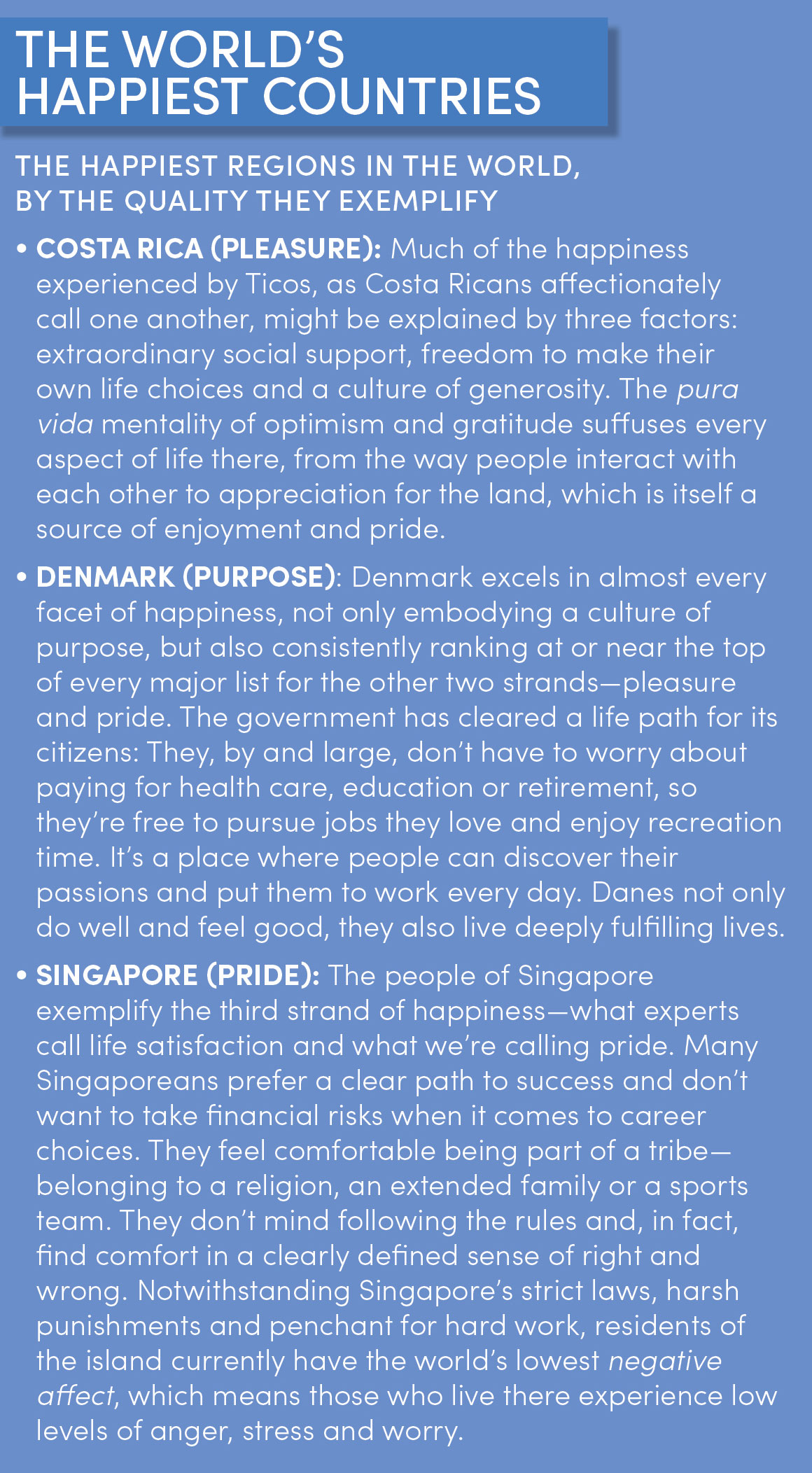Who is the world’s happiest person?
He might be a 55-year-old father who lives in Cartago, Costa Rica. He socializes at least six hours a day and has a handful of good friends. He sleeps between seven and nine hours per night, wakes to a big breakfast, walks to work and eats at least six servings of vegetables per day. He’s a soccer fan. He puts in fewer than 40 hours per week at a job with friends he enjoys being around. He watches no more than an hour of TV a day. He spends at least two hours every week volunteering, and he worships on the weekend. He makes enough money for food, a roof over his family’s heads, schooling for his children and basic health care. He trusts the local police, the politicians governing his country and his neighbors.
We’ll call him Alejandro.
Or she might be a young woman living near Aalborg, Denmark. The daughter of an educated mother, she lives with her husband and two young daughters in a tightly knit neighborhood with 21 other families who share a large garden, toolshed and community kitchen. She works as a development consultant in social psychology, a job that challenges her and allows her to put her strengths and passions to work every day. She’s an extrovert who married an introvert, but she and her husband share values, and over the years, they’ve cultivated a strong love for each other. She doesn’t raise her children alone—the neighborhood does. Kids play together, run in and out of neighbors’ houses and sometimes stay overnight with one another. Most of her neighbors are friends with whom she socializes about six hours per day. She and her family bicycle to work, the store and school. She pays high taxes on her modest salary, but in return, she receives health care and education for her family.
We’ll call her Sidse.
Or maybe the world’s happiest person lives in Singapore. He drives a $750,000 BMW and lives in a $10 million house. He has a beautiful wife and three well-behaved, hardworking children. He grew up without a lot of money, but he put himself through school working four jobs and eventually started a company that grew into an $80 million multinational enterprise. He puts in about 60 hours per week, splitting his time between his business and philanthropic work. He’s loved by his family, respected by his employees, honored by his country and envied by his peers. Although he’s succeeded largely because of his own hard work and ingenuity, he leads from behind, freely sharing the credit for his accomplishments. He’s proud of his country, happily pays his taxes and has given back millions of dollars over the years to his community.
We’ll call him Douglas.
Alejandro, Sidse and Douglas are all real people. The details of their lives map the three basic strands of well-being. I call them the three P’s of happiness: pleasure, purpose and pride. Alejandro exemplifies pleasure, Sidse represents purpose and Douglas embodies pride. At first glance, these strands might seem quite different from one another, but we often find them braided together in the lives of the world’s happiest people.
The people who live in the world’s happiest places manage to weave all three P’s of happiness into their lives. They combine pleasure, purpose and pride into a resilient form of well-being. They follow the interests of their hearts with enthusiasm, but not at the expense of feeling joy and laughter, and they look with pride on what they are doing or what they have already accomplished. In many cases, they’re able to do this because the places where they live—their nations, communities and households—give them an invisible lift, constantly nudging them into behaviors that favor long-term well-being.

This formula for happiness builds on a methodology I developed for unraveling the secrets of the world’s longest-lived people. In 2002, with a grant from the National Institutes of Aging, I commissioned a team to identify places where people lived the longest. Together with Michel Poulain, Ph.D., a Belgian demographer, and Gianni Pes, M.D., an Italian physician and medical statistician, we identified five areas we called the world’s Blue Zones: Okinawa, Japan; Sardinia, Italy; Nicoya, Costa Rica; Ikaria, Greece; and Loma Linda, California. I published a book on these places, The Blue Zones: Lessons for Living Longer From the People Who’ve Lived the Longest.
So why has a project initially focused on health turned its spotlight on happiness? Because our experience, echoed by recent studies, shows that the connection between health and happiness is a two-way street. People with positive attitudes tend to smoke less and exercise more, eat better foods, wear their seat belts more often, take their medication more regularly, have stronger immune systems, and enjoy better cardiovascular health. There’s also evidence that happier people recover from illnesses faster, that emotional vitality reduces the risk of strokes and even that an optimistic spouse can improve a patient’s outcome. Being happy actually helps you become healthier.
As proven by the people who live in the world’s happiest places—from the rural villages of Costa Rica to the crowded skyscrapers of Singapore—lasting happiness isn’t something just for privileged, suburban, latte-drinking, yoga-practicing Americans. It’s something everyone can create for themselves and their families—whether they’re farmers, suburbanites or city folks. No matter where you live, you can arrange your house, curate your social network, manage your finances, optimize your work life and ground yourself in meaning and purpose. You can stack the proverbial deck in favor of the most joyful, fulfilling and appropriate life for you.
In short, you can make changes in your life that will combine all three strands of happiness—pleasure, pride and purpose—into a strong, durable rope.
***
So how can you set up your life to favor greater happiness? The first step is to figure out how happy you are.
This test has been designed to help you evaluate how various factors in your life contribute to your experience of pleasure, purpose and pride.
To learn where you can make a difference in changing your environment to optimize happiness, pay special attention to any of the three columns to the right where your score falls short of 20.
If your total for the Pleasure column is less than 20, that could mean you need to look for more ways to add fun, awe and joy to your daily routine. You might rearrange your living space so it’s easier to entertain guests, or find a way to work closer to home. The people of Costa Rica are famous for enjoying life, which they describe as pura vida. They practice this special version of happiness by socializing as much as possible, setting a helpful example for the rest of us. Spending time with friends or making new ones can open up a world of possibilities for those of us who want more joy in our lives.
If your total for the Purpose column is less than 20, you might not have enough opportunities in your daily life to use your gifts and talents in pursuit of a meaningful goal. In that case, you can make adjustments, from listening to meaningful podcasts during your daily commute to regularly walking a dog. The Danes taught me a lot about living a purposeful life during the time I spent with them. In their view, the best pursuits in life are those that fuel your soul, rather than those that add to your bank account or build up your ego. That’s reflected in the fact that Danes work an average of only about 37 hours a week, which gives them ample time to pursue fulfilling hobbies.
If your total for the Pride column falls short of 20, that could mean you’ve let your life become too busy and you can’t point to anything significant that gives you a rewarding sense of accomplishment. In that case, you might look for ways to align your job with your personal interests, set up an automatic savings plan for retirement, or put healthy foods front and center in your kitchen to create a better environment for your health. Singapore is a prime example of what a life of pride in accomplishment looks like. Success in that small island nation means advancing your education, getting a good job, providing for your family and generally meeting or exceeding the expectations of society. Although that might require sacrificing personal pleasure from time to time, it actually brings great satisfaction to Singaporeans.
Taking the Blue Zones Happiness Test is the first step in cultivating a greater sense of happiness. Through it, you have learned something about the unique mix of ingredients in your own happiness recipe, and you have learned whether you are shortchanging yourself in one dimension or another.
Our environments and many of our life choices support one of the three strands of happiness. Some combine two of the strands. Those most likely to bring happiness are the environments and choices in the middle, where all three strands converge. It’s up to you to find your way to that happy middle.
Excerpted from The Blue Zones of Happiness: Lessons from the World’s Happiest People [Copyright © 2017] by Dan Buettner, published by National Geographic October 3, 2017. [Reprinted with permission of the publisher.] This article originally appeared in the December 2017 issue of SUCCESS magazine. Photo by @atercorv/Twenty20


